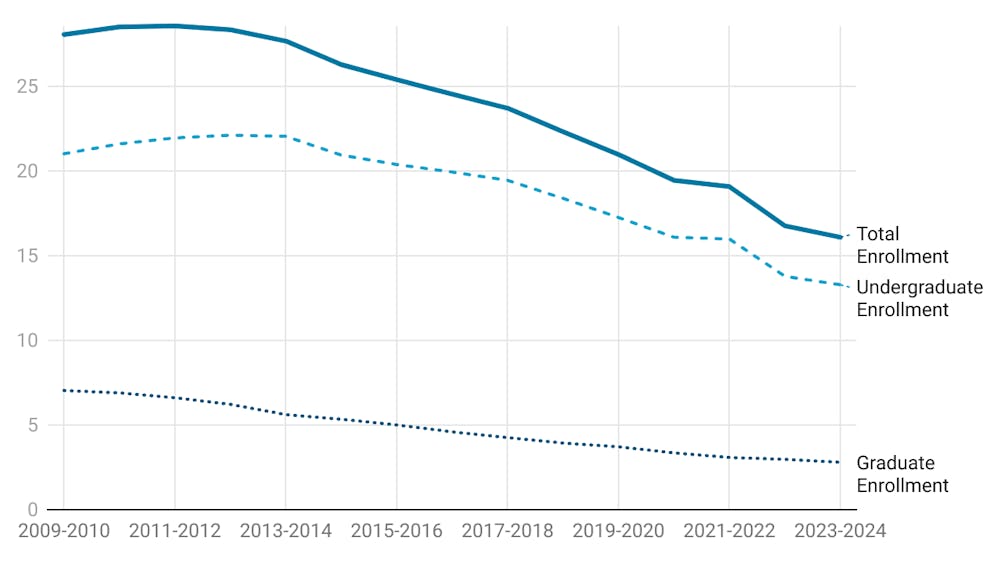Eastern Michigan University has a wealth of free resources available to its students to help them succeed during their college careers.
An example of these resources is the Disability Resource Center, formerly known as the Students with Disabilities Office.
One of the DRC’s main goals is to collaborate with students, faculty and staff to create an educational environment inclusive to all.
According to Dr. Adam Meyer, senior director of student success within Academic Affairs, the DRC is one of 22 national higher education disability offices that is part of a federal grant project dedicated to redesigning how campus disability services are coordinated and provided throughout campus.
“The main premise of the project is that the environment is more disabling than the disability,” he said. “Environments are full of barriers that include and exclude all people.”
Meyer said most of EMU’s campus is handicapped accessible.
“Most buildings and the well-traveled areas are accessible, though every entryway is not accessible,” he said. “In my assessment, EMU is on par with most other institutions of higher education. We have an accessible campus with some great strengths — such as the Student Center, which was built with accessibility in mind — along with some areas that could use improvement.”
Due to the size and age of some of the buildings on Eastern’s campus, areas of improvement are expected, but the center has created a special committee dedicated to examining and fixing potential problem areas.
The Campus Accessibility Committee’s sole purpose is to analyze where improvements to campus accessibility can be made.
“We are also taking a greater look at the impact of the environment on a student situation, as the environment is often more disabling than the medical disability itself,” Meyer said. “For example, a person in a wheelchair who cannot enter a building that has ten stairs leading into the only door with no ramp is excluded from the building not because of use of the wheelchair, but because the building was not built to be accessible for everyone.”
When the word accessibility comes to mind, many think of it in the terms of a physical form, but accessibility comes in a variety of forms and modalities, Meyer said.
“When people think disability, they think about physical accessibility, but there is so much more to access than physical structures,” Meyer said. “For example, a class where the only form of grade assessment is multiple choice exams can be a barrier for students with dyslexia.
“Multiple choice exams can also be a barrier for students who are stronger writers than they are readers. In these situations, a student may earn a lower grade in a class because the format of the class was not compatible with the student’s learning and assessment strengths, not necessarily because the student did not comprehend the course information.”
The Disability Resource Center currently works with approximately 350 students, but there are more students with disabilities who choose not to contact the office because they do not need formal accommodations in most cases.
“National numbers at an institution of EMU’s size suggests that we have anywhere from 1,000 – 1,500 students with some type of disability,” Meyer said. “Disability is perhaps more prevalent than people realize because most disabilities are invisible.”
Dr. Silva Goncalves, assistant director of the disability resource center, said the actual percentages do not reflect absolute numbers of students with disabilities.
“Some individuals have multiple disabilities,” she said “Another consideration is that some diagnoses are increasing in numbers more than others: post-traumatic stress disorder, autism and attention deficit hyperactivity disorder.”
Goncalves said in order to receive accommodations students should contact the office to schedule an intake or appointment.
According to Goncalves, an adviser will meet with students individually to review his or her needs, their history of accommodations and then the adviser prepares a letter of accommodation for the student that they then must forward to all of their professors.
Accommodations cannot only be made in the classroom but sometimes in housing as well.
“Students who need special accommodations in Housing must also contact the Disabilities Resources Center and register with our office,” Goncalves said. “We will then send a recommendation to Housing. For instance, a student in a wheelchair may need to live on the first floor or near an elevator; a student with sleeping disorders may have a private room assigned.”
Meyer said the center works closely with the Housing Department to try to accommodate as many students as possible.
“We evaluate appropriate requests on a case-by-case basis,” he said. “Some rooms are built with accessibility in mind, but students often have housing requests beyond what can be addressed through the physical structure of the room.”
Meyer is hopeful progress will continue to be made so students won’t have to come to the resource center as much.
“I would eventually like to get to the point where there is less and less need for the student to contact the Disability Resource Center because people throughout campus are taking proactive steps to make the campus and campus experiences accessible for all students regardless of personal situation or campus situation,” he said.
Meyer said generally, most students are satisfied with the help they receive from the center and from their professors as well.
“Many students report that professors are extremely understanding and positive to work with when it comes to coordinating accommodations,” he said.
Dr. Goncalves said if a problem does arise, it is usually due to a lack of understanding about the law, university policies and procedures.
“If a student is not receiving the accommodations she/he needs in class it is important to contact our office and we will assist the student to work things out with the professor,” she said.
For help outside of the Disability Resource Center, students can go to places on campus such as the Holman Learning Center and the Center for Adaptive Technology Education Lab, which serves students with disabilities.
The CATE lab has Braille printers, voice recognition systems and other forms of technology to assist students. Holman has resources to provide things such as one-on-one academic support and accommodations for student exams.
Meyer wants the campus community to be aware of the upcoming Disabilities Awareness Week taking place Oct. 24-29.
“At this time, the known highlights of the week include a Close-Up presentation on disability on Oct. 24, national speaker Marcus Engel on Oct. 26 and national speaker and comedian Josh Sundquist via Skype on Oct. 28,” he said. “We are still finalizing the plans for that week and look forward to what will be presented to the campus community.”








